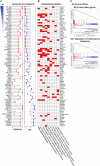Excessive Neutrophils and Neutrophil Extracellular Traps in COVID-19
- PMID: 33013872
- PMCID: PMC7461898
- DOI: 10.3389/fimmu.2020.02063
Excessive Neutrophils and Neutrophil Extracellular Traps in COVID-19
Abstract
Background: Cases of excessive neutrophil counts in the blood in severe coronavirus disease (COVID-19) patients have drawn significant attention. Neutrophil infiltration was also noted on the pathological findings from autopsies. It is urgent to clarify the pathogenesis of neutrophils leading to severe pneumonia in COVID-19. Methods: A retrospective analysis was performed on 55 COVID-19 patients classified as mild (n = 22), moderate (n = 25), and severe (n = 8) according to the Guidelines released by the National Health Commission of China. Trends relating leukocyte counts and lungs examined by chest CT scan were quantified by Bayesian inference. Transcriptional signatures of host immune cells of four COVID19 patients were analyzed by RNA sequencing of lung specimens and BALF. Results: Neutrophilia occurred in 6 of 8 severe patients at 7-19 days after symptom onset, coinciding with lesion progression. Increasing neutrophil counts paralleled lesion CT values (slope: 0.8 and 0.3-1.2), reflecting neutrophilia-induced lung injury in severe patients. Transcriptome analysis revealed that neutrophil activation was correlated with 17 neutrophil extracellular trap (NET)-associated genes in COVID-19 patients, which was related to innate immunity and interacted with T/NK/B cells, as supported by a protein-protein interaction network analysis. Conclusion: Excessive neutrophils and associated NETs could explain the pathogenesis of lung injury in COVID-19 pneumonia.
Keywords: COVID-19; coronavirus; lymphopenia; neutrophil extracellular trap; neutrophilia; pneumonia.
Copyright © 2020 Wang, Li, Yin, Zhang, Cao, Lin, Huang, Hoffmann, Lu and Qiu.
Figures






Similar articles
-
Re-analysis of Single Cell Transcriptome Reveals That the NR3C1-CXCL8-Neutrophil Axis Determines the Severity of COVID-19.Front Immunol. 2020 Aug 28;11:2145. doi: 10.3389/fimmu.2020.02145. eCollection 2020. Front Immunol. 2020. PMID: 32983174 Free PMC article.
-
Neutrophil extracellular traps contribute to immunothrombosis in COVID-19 acute respiratory distress syndrome.Blood. 2020 Sep 3;136(10):1169-1179. doi: 10.1182/blood.2020007008. Blood. 2020. PMID: 32597954 Free PMC article.
-
Devilishly radical NETwork in COVID-19: Oxidative stress, neutrophil extracellular traps (NETs), and T cell suppression.Adv Biol Regul. 2020 Aug;77:100741. doi: 10.1016/j.jbior.2020.100741. Epub 2020 Jul 4. Adv Biol Regul. 2020. PMID: 32773102 Free PMC article. Review.
-
SARS-CoV-2-triggered neutrophil extracellular traps mediate COVID-19 pathology.J Exp Med. 2020 Dec 7;217(12):e20201129. doi: 10.1084/jem.20201129. J Exp Med. 2020. PMID: 32926098 Free PMC article.
-
Hematological findings in coronavirus disease 2019: indications of progression of disease.Ann Hematol. 2020 Jul;99(7):1421-1428. doi: 10.1007/s00277-020-04103-5. Epub 2020 Jun 3. Ann Hematol. 2020. PMID: 32495027 Free PMC article. Review.
Cited by
-
Proteomics reveals antiviral host response and NETosis during acute COVID-19 in high-risk patients.Biochim Biophys Acta Mol Basis Dis. 2023 Feb;1869(2):166592. doi: 10.1016/j.bbadis.2022.166592. Epub 2022 Nov 1. Biochim Biophys Acta Mol Basis Dis. 2023. PMID: 36328146 Free PMC article.
-
The role of co-infections and secondary infections in patients with COVID-19.Pneumonia (Nathan). 2021 Apr 25;13(1):5. doi: 10.1186/s41479-021-00083-w. Pneumonia (Nathan). 2021. PMID: 33894790 Free PMC article. Review.
-
[Role of the immune system in SARS-CoV-2 infection: immunopathology of COVID-19].Medicine (Madr). 2021 May;13(33):1917-1931. doi: 10.1016/j.med.2021.05.005. Epub 2021 May 27. Medicine (Madr). 2021. PMID: 34075268 Free PMC article. Spanish.
-
Gut Microbiota Disruption in COVID-19 or Post-COVID Illness Association with severity biomarkers: A Possible Role of Pre / Pro-biotics in manipulating microflora.Chem Biol Interact. 2022 May 1;358:109898. doi: 10.1016/j.cbi.2022.109898. Epub 2022 Mar 21. Chem Biol Interact. 2022. PMID: 35331679 Free PMC article. Review.
-
Laboratory Findings in Different Disease Status of COVID-19 Admitted Patients at Dilla University Referral Hospital Treatment Center, South Ethiopia.Infect Drug Resist. 2022 Aug 8;15:4307-4320. doi: 10.2147/IDR.S370907. eCollection 2022. Infect Drug Resist. 2022. PMID: 35965852 Free PMC article.
References
-
- WHO . Coronavirus Disease (COVID-2019) Situation Reports. Available online at: https://www.who.int/emergencies/diseases/novel-coronavirus-2019/situatio... (accessed March 30, 2020).
-
- WHO Clinical Management of Severe Acute Respiratory Infection When Novel Coronavirus (nCoV) Infection Is Suspected. Geneva: World Health Organization; (2020). Available online at: https://apps.who.int/iris/handle/10665/330893 (accessed January 28, 2020).
Publication types
MeSH terms
Substances
LinkOut - more resources
Full Text Sources
Other Literature Sources

